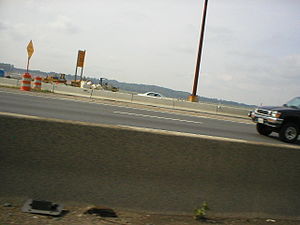Jersey barrier
820mm High
710mm Wide at base
250mm Wide at top
These barriers are NOT the interlocking type for use on Vic Roads roads, they are for use on private property only. We do NOT supply Highway use Barriers.
If you need impressions in the bottom to be able to move the barrier yourself with a forklift then you need to advise us when ordering. Not all forklifts have the same tyne dimensions and tyne spread so we would need to custom suit the dimensions and spread to suit your forklift.
A Jersey barrier or Jersey wall separates lanes of traffic (often opposing lanes of traffic) with a goal of minimising vehicle crossover in the case of accidents. They have also come into use as a means to keep car bombs away from perceived targets.
If you specifically ask us for impressions for use with forklifts then by default the impressions will be made at 900mm apart (to the centre of the impressions) and each impression is 170mm wide x 60 mm high. If you need the impressions to be a different size or width apart then you will need to tell us when you are making the order.
Development and use
The Jersey barrier was originally developed at Stevens Institute of Technology in Hoboken, N.J. (under the direction of the New Jersey State Highway Department) to divide multiple lanes on a highway by the state of New Jersey in the United States. A Jersey barrier stands 3 feet tall and is made of poured concrete. Their widespread use on the highway has led to many other uses as a general barrier (for instance, during general construction projects or constructing temporary walkways). They are also known as temporary concrete traffic barriers or
traffic dividers.

Below is an image of the component used in the tops of our Jersey barriers. The component you'll need for rigging your crane to the barrier is called a SWIFT LIFT. By attaching the SWIFT LIFTS to your crane you can manoeuvre the barriers into place and from place to place. Each SWIFT LIFT component is rated to 5 tonne.

Jersey barriers are concrete barriers originally developed for highway medians.
The design of the Jersey barrier was specifically intended to minimise damage and reduce the likelihood of a car crossing into oncoming lanes in the event of a collision For the more common shallow angle hits, the Jersey barrier is intended to minimise sheet metal damage by allowing the vehicle tires to ride up on the lower sloped face.
For higher impact angles, the Jersey barrier is actually a multistage barrier. The front bumper impacts the upper sloped face and slides upwards. This interaction initiates lifting of the vehicle. If the bumper is relatively weak, the front end starts to crush before any uplift occurs. Then, as the vehicle becomes more nearly parallel with the barrier, the wheel contacts the lower sloped face. Most of the additional lift of the vehicle is caused by the lower sloped face compressing the front suspension. However, wheel side-scrubbing forces provide some additional lift, particularly if the barrier face is rough. Therefore, exposed aggregate and other rough surface finishes should be avoided. Modern vehicles have relatively short distances between the bumper and the wheel; as a result, bumper contact is followed almost immediately by wheel contact.
It is only necessary to lift the vehicle enough to reduce the friction between the tires and the paved surface. This aids in banking and redirecting the vehicle. If the vehicle is lifted too high into the air, it may yaw, pitch, or roll, which can cause the vehicle to roll over when the wheels come in contact with the ground again. Concrete safety shape barriers should be adjacent to a paved surface so that the wheels cannot dig into the soil and cause the vehicle to overturn.
In the State of New Jersey the term "Jersey barrier" is rarely used. Residents, government agencies, and road traffic and media reports on radio and television (including stations located in New York City and Philadelphia) usually use the term "traffic divider".
The older guard rail barrier system did not prevent traffic from entering oncoming traffic. New Jersey first used concrete traffic barriers in 1955. The current shape was first implemented in 1959 as a result not of crash testing, but of police observation of the accident results of previously installed concrete barriers.
Jersey barriers have been used extensively in the American occupation of Iraq to fortify road-blocks and public infrastructure, along with modern "T" and "L" barriers, much taller variants.

Jersey wall on the Woodrow Wilson Bridge near Washington, D.C.
From Wikipedia, the free encyclopedia
Items may differ in appearance to images shown.
See below for more info and related products
MORE INFO & RELATED PRODUCTS
Advanced Group's Jersey Barriers

